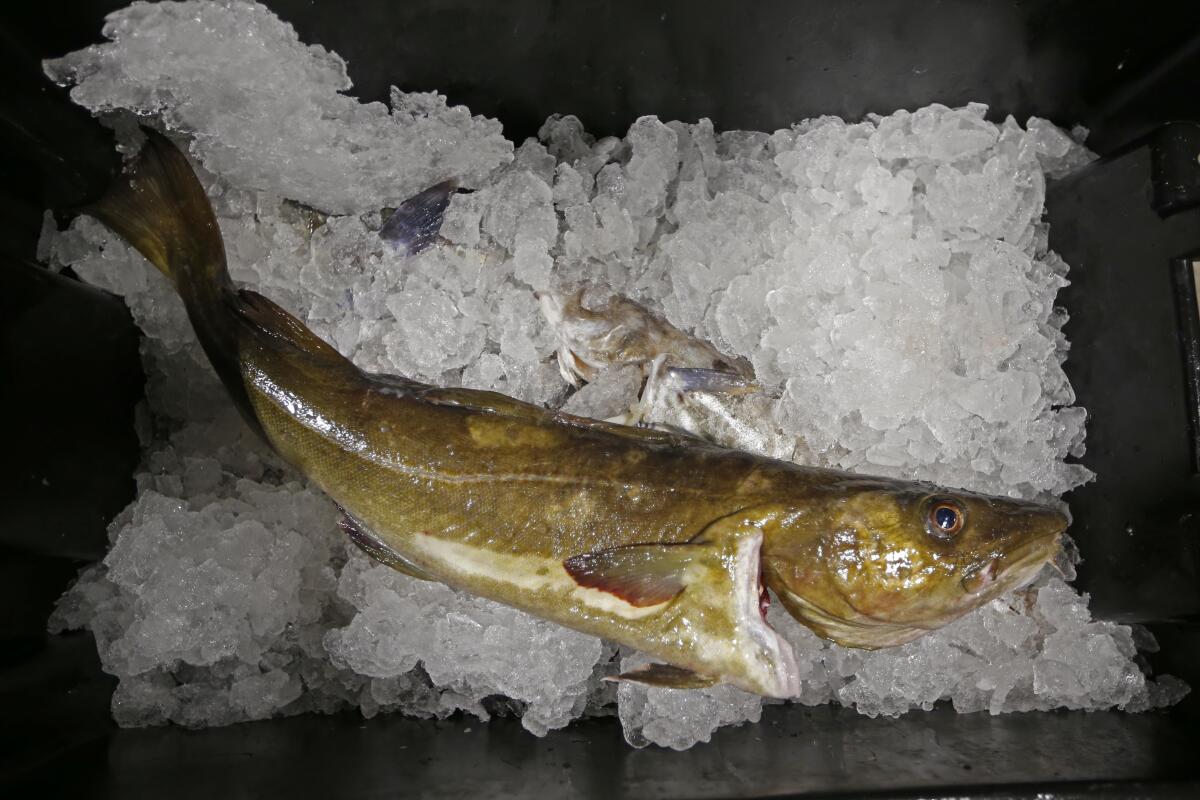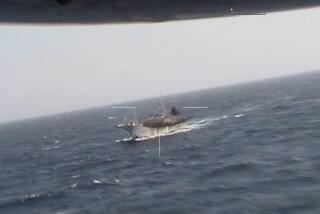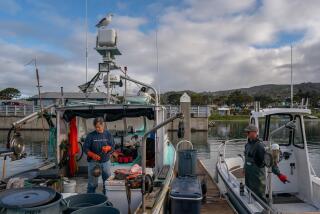Putin’s pollock: U.S. seafood imports fuel Russian war machine

- Share via
A U.S. ban on seafood imports from Russia over its invasion of Ukraine was supposed to sap billions of dollars from Vladimir Putin’s war machine.
But shortcomings in import regulations mean that Russian-caught pollock, salmon and crab are likely to enter the U.S. anyway, by way of the country vital to seafood supply chains across the world: China.
Like the U.S. seafood industry, Russian companies rely heavily on China to process their catch. Once there, the seafood can be reexported to the U.S. as a “product of China” because country of origin labeling isn’t required.
The result is that nearly a third of the wild-caught fish imported from China is estimated to have been caught in Russian waters, according to an International Trade Commission study of 2019 data. For pollock and sockeye salmon, the rate is even higher — 50% to 75%.
“China doesn’t catch cod. They don’t catch pollock. But yet, they’re one of the largest exporters of these whitefish in the world,” said Sally Yozell, a former policy director at the National Oceanic and Atmospheric Administration who now is a senior fellow at the Stimson Center in Washington. “Having it labeled as a Chinese product is really not fair to the consumers and to restaurants.”
Fishing is big business in Russia, one closely linked to the Kremlin and Putin’s projection of power at sea. The country is the one of the world’s top seafood producers and was the eighth-largest exporter to the U.S. last year, with more than $1.2-billion worth of sales, the bulk of it king crab.
But it’s unknown exactly how much manages to land in the U.S. by way of China, which sent an additional $1.7 billion in fish to the U.S. last year. Nor does the Biden administration’s ban require companies importing from China to find out.
Among Russia’s biggest seafood exports is Alaska pollock. A cousin of cod, Alaska pollock is the most harvested fish in the U.S., showing up in everything from imitation crabmeat to McDonald’s Filet-O-Fish. Every year, giant, floating factories in the Bering Sea and Gulf of Alaska catch 1.5 million metric tons of the fish, the equivalent of more than four times the weight of the Empire State Building.
But the same species is also harvested in Russia in similar amounts, and once processed and imported from China, fills an important gap in the U.S. market. In lieu of tracing the country of origin, U.S. producers rely on the name recognition of Alaska pollock to signal where the fish was caught.
“Consumers can have confidence that if the name Alaska is on the box it unequivocally comes from Alaskan waters,” said Craig Morris, chief executive of Genuine Alaska Pollock Producers.
Even before the invasion of Ukraine, pressure had been building to prevent what Sen. Dan Sullivan, an Alaska Republican, called “authoritarian” pollock from entering the U.S. Putin banned U.S. seafood in 2014 following American sanctions to punish him for the invasion of Crimea that year. Since then, Russian exports entering the U.S. duty free have nearly quadrupled in value.
U.S. trade data analyzed by the Associated Press show that the biggest importer of Russian-caught pollock from China last year was High Liner Foods. The company did not respond to the AP’s request for comment.
While overshadowed by Russia’s role as an energy powerhouse, Russia’s seafood industry has increasingly been flexing its muscle with strong support from the Kremlin.
Two of the country’s largest seafood exporters — Vladivostok-based Russian Fishery Co. and Russian Crab — are owned by Gleb Frank, the son of Putin’s former transportation minister and head of state-owned shipbuilder Sovcomflot. Frank, dubbed Russia’s “Crab King,” is also the son-in-law of one of Russia’s richest men, Gennady Timchenko, who was among the first oligarchs sanctioned following the 2014 invasion of Crimea.
With generous state loans, Frank’s companies have been at the forefront of an effort to renew Russia’s aging fleet. Last year, during a Navy Day ceremony at a St. Petersburg shipyard with Putin and 50 warships looking on, he launched an advanced supertrawler capable of hauling 60,000 tons of pollock per year.
After Frank was hit with U.S. sanctions last month, he sold part of his ownership stakes in both seafood companies and resigned as chairman. Russian Fishery Co. did not respond to a detailed list of questions about the U.S. embargo, but Russian Crab said Frank has never played a role in management of the company.
It’s not just the industry’s ties to the Kremlin that are driving concern.
For years, activists have complained about Russia’s poor record caring for the oceans. The country was ranked No. 2 out of 152 nations in a recent study of global efforts to combat illegal, unregulated and unreported fishing. Only China scored worse.
Allegations of illegal fishing have even followed Russia to the south pole, where a Russian ship in 2020 was accused of faking its location data to fish illegally off season. A Russian observer was also found to be behind anomalous catch data from several Antarctic fishing vessels. In both cases, Russia denied any wrongdoing.
At a congressional hearing this month on the Russian seafood ban, Rep. Jared Huffman (D-San Rafael) led calls for the expansion of NOAA’s Seafood Import Monitoring Program, which aims to prevent illegal seafood from entering U.S. supply chains by tracking shipments from the point of catch. Currently the program covers just 13 species, only two of which — red king crab and Atlantic cod — are fished by Russia.
“Until that happens, Russian seafood will continue to line grocery store shelves and American consumers will continue to unwittingly support Putin’s war machine,” Huffman said.
Peter Quinter, a former U.S. Customs Service attorney, said the Biden administration can easily close the China loophole by requiring importers to inspect their supply chains to make sure none of their fish comes from Russia.
“They can and should fix this,” said Quinter, who now advises seafood companies on compliance with American trade law. “The old days of being sure your fish is caught in a single place or country is no longer the case.”
More to Read
Sign up for Essential California
The most important California stories and recommendations in your inbox every morning.
You may occasionally receive promotional content from the Los Angeles Times.










